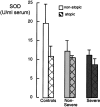Correlation of systemic superoxide dismutase deficiency to airflow obstruction in asthma
- PMID: 15883124
- PMCID: PMC2718470
- DOI: 10.1164/rccm.200502-180OC
Correlation of systemic superoxide dismutase deficiency to airflow obstruction in asthma
Abstract
Rationale: Increased oxidative stress and decreased superoxide dismutase (SOD) activity in the asthmatic airway are correlated to airflow limitation and hyperreactivity. We hypothesized that asthmatic individuals with higher levels of oxidative stress may have greater loss of SOD activity, which would be reflected systemically in loss of circulating SOD activity and clinically by development of severe asthma and/or worsening airflow limitation.
Methods: To investigate this, serum SOD activity and proteins, the glutathione peroxidase/glutathione antioxidant system, and oxidatively modified amino acids were measured in subjects with asthma and healthy control subjects.
Results: SOD activity, but not Mn-SOD or Cu,Zn-SOD protein, was lower in asthmatic serum as compared with control, and activity loss was significantly related to airflow limitation. Further, serum SOD activity demonstrated an inverse correlation with circulating levels of 3-bromotyrosine, a posttranslational modification of proteins produced by the eosinophil peroxidase system of eosinophils. Exposure of purified Cu,Zn-SOD to physiologically relevant levels of eosinophil peroxidase-generated reactive brominating species, reactive nitrogen species, or tyrosyl radicals in vitro confirmed that eosinophil-derived oxidative pathways promote enzyme inactivation.
Conclusion: These findings are consistent with greater oxidant stress in asthma leading to greater inactivation of SOD, which likely amplifies inflammation and progressive airflow obstruction.
Figures







References
-
- Gaston B, Drazen JM, Loscalzo J, Stamler JS. The biology of nitrogen oxides in the airways. Am J Respir Crit Care Med 1994;149:538–551. - PubMed
-
- MacPherson JC, Comhair SA, Erzurum SC, Klein DF, Lipscomb MF, Kavuru MS, Samoszuk MK, Hazen SL. Eosinophils are a major source of nitric oxide-derived oxidants in severe asthma: characterization of pathways available to eosinophils for generating reactive nitrogen species. J Immunol 2001;166:5763–5772. - PubMed
-
- Haahtela T. Airway remodelling takes place in asthma: what are the clinical implications? Clin Exp Allergy 1997;27:351–353. - PubMed
Publication types
MeSH terms
Substances
Grants and funding
- HL69174/HL/NHLBI NIH HHS/United States
- HL69170/HL/NHLBI NIH HHS/United States
- HL69116/HL/NHLBI NIH HHS/United States
- M01 RR018390/RR/NCRR NIH HHS/United States
- HL 07649/HL/NHLBI NIH HHS/United States
- AI70649/AI/NIAID NIH HHS/United States
- HL69349/HL/NHLBI NIH HHS/United States
- HL69167/HL/NHLBI NIH HHS/United States
- HL69155/HL/NHLBI NIH HHS/United States
- U10HL74225/HL/NHLBI NIH HHS/United States
- HL61878/HL/NHLBI NIH HHS/United States
- HL04265/HL/NHLBI NIH HHS/United States
- HL69130/HL/NHLBI NIH HHS/United States
- P01/U01HL67663/HL/NHLBI NIH HHS/United States
LinkOut - more resources
Full Text Sources
Other Literature Sources
Medical

